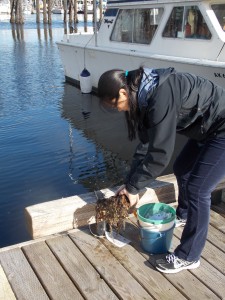
Sixth graders were in Petersburg’s Middle Harbor Thursday morning checking for an invasive species that has shown up on the waterfront not too far away in Sitka. So far there’s no sign yet of the tunicate called D Vex here.
Middle school science teacher Alice Cumps leans over the side of a harbor float and pulls up a brick, and PVC plate dangling from the side of the float a couple feet underwater on a rope.
“This is a project through the Smithsonian Institute,” Cumps explained. “It’s part of their citizen science program, kind of an outreach organization and I think they’re all up and down the west coast. So we are one of the Alaska spots that’s agreed to participate in this monitoring program, monitoring to look for and hopefully not find invasive tunicates in our local harbors here.”
Sixth grader John Bisset explained what the students are pulling up. “It’s a rope, attached to a brick and on the bottom of that brick is a plate where we will hopefully find something interesting,” he said.
The students are joining volunteers from Prince Rupert British Columbia out to the Aleutian Islands in keeping an eye out for the marine invertebrate called didemnun vexillim, or D Vex. It resembles a light colored mat or sponge that can spread over the sea floor and also grow on docks and boats and other structures under water. The tunicate found its way to one of Sitka’s harbors, likely more than a decade ago arriving there on some imported oyster farm equipment. This summer the state of Alaska and the Smithsonian started testing methods for killing the tunicate in Sitka.
“They’re kind of like an animal that covers things,” said Petersburg middle schooler Kara Newman. “And so they could block out other animals from eating things on the rocks. And it would be really bad for the native food chain.”
Newman said she’s learned about how the animal spreads. “I’m pretty sure their home place where they’re originally from is Japan and when they had their tsunami, stuff from Japan that had the tunicates on them was washed out to sea and placed around the world. It’s actually kind of interesting if you look it up about invasive species and how they can get to other places by the ocean and other things. We had a big class about it, invasive species and everything.”
Petersburg High School students led by teacher Joni Johnson have been helping with the monitoring effort since 2008. Cumps, who is Johnson’s replacement for science classes in the middle and high school, says the fifth graders got involved with the project last year.
“So they deployed these as fifth graders with Mr. Sullivan’s class,” Cumps said. “And we just thought it’d be a neat way for them to follow it with them, since they deployed them, we’ll pick ‘em back up and they get to try to identify them and we’ll take some collection data that actually gets sent back to the institute and becomes part of the national database which is kind of a neat process for them to be involved in.”
Cumps said her high school class already retrieved eight plates from South Harbor this year. “We just finished, wrapped up the data collection there and didn’t find anything unusual which was good. Probably I think Mr. Sullivan’s class will deploy another set in the spring. So we’ll let them sit all spring and summer and we’ll pull ‘em up.”
The six graders found most of the 10 plates hung in middle harbor this year and carried them in buckets back to the middle school for a closer look.
Joe Viechnicki is a reporter at KFSK in Petersburg.




